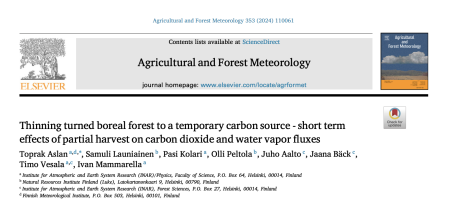
Resource description:
Even though the effect of thinning on CO2 and H2O fluxes has been widely investigated, a holistic description of thinning-induced responses is yet to be provided. Here, we present a comprehensive study, investigating the impact of commercial thinning in an even-aged boreal forest in southern Finland using concurrent above- and sub-canopy eddy-covariance measurements and a process-based ecosystem model. The thinning was done from below and removed ca. 40% of the basal area. The forest turned from a strong sink (−271 gCm−2yr−1) to a moderate carbon source (+115 gCm−2yr−1) during the year of thinning due to decreased ecosystem gross primary productivity (GPP) and simultaneous increase in ecosystem respiration (R). The reduced canopy density increased the light availability, near-ground air temperature and wind speed. This improved the photosynthetic efficiency of the remaining trees, resulting in only a moderate reduction in GPP (ca. 20%) compared to the foliage loss (ca. 45%). The decomposition of cutting residue likely increased the heterotrophic respiration that compensated for the reduced autotrophic respiration of removed trees, leading to R exceeding long-term average by ca. 10% during the year of thinning. Interestingly, thinning did not affect ecosystem evapotranspiration but changed its partitioning: both stand transpiration and interception evaporation decreased, whereas forest floor evapotranspiration increased. The inter-annual weather variability did not notably affect annual fluxes, which enabled robust quantification of thinning impacts. Our results show a strong qualitative resemblance with previously reported short-term responses of boreal forest to thinning. This is presumably due to similar management practices and species composition among the studies, and low variability of inter-annual weather and fluxes. Our study showed that sub-canopy eddy covariance measurements and process-based model can play a pivotal role in disentangling the confounding responses of forest floor and canopy to thinning.
Author/Contact:
Toprak Aslan, Samuli Launiainen, Pasi Kolari, Olli Peltola, Juho Aalto, Jaana Bäck, Timo Vesala, Ivan Mammarella